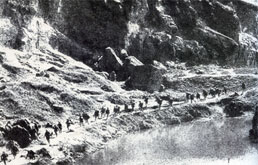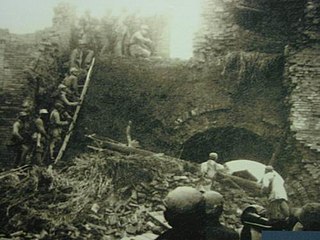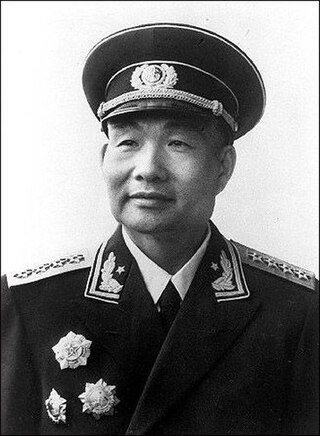Related Research Articles

Liu Bocheng was a Chinese military commander and Marshal of the People's Liberation Army.

The Burma campaign was a series of battles fought in the British colony of Burma. It was part of the South-East Asian theatre of World War II and primarily involved forces of the Allies against the invading forces of the Empire of Japan. Imperial Japan was supported by the Thai Phayap Army, as well as two collaborationist independence movements and armies. Nominally independent puppet states were established in the conquered areas and some territories were annexed by Thailand. In 1942 and 1943, the international Allied force in British India launched several failed offensives to retake lost territories. Fighting intensified in 1944, and British Empire forces peaked at around 1 million land and air forces. These forces were drawn primarily from British India, with British Army forces, 100,000 East and West African colonial troops, and smaller numbers of land and air forces from several other Dominions and Colonies. These additional forces allowed the Allied recapture of Burma in 1945.

The Battle of Pingxingguan, commonly called the Great Victory of Pingxingguan in Mainland China, was an engagement fought on 25 September 1937, at the beginning of the Second Sino-Japanese War, between the Eighth Route Army of the Chinese Communist Party and the Imperial Japanese Army.

The Battle of Xinkou was a decisive engagement of the Taiyuan Campaign, the second of the 22 major engagements between the National Revolutionary Army and Imperial Japanese Army during the Second Sino-Japanese War.

The Shangdang Campaign was a series of battles fought between Eighth Route Army troops led by Liu Bocheng and Kuomintang troops led by Yan Xishan in what is now Shanxi Province, China. The campaign lasted from 10 September 1945, through 12 October 1945. Like all other Chinese Communist victories in the clashes immediately after Imperial Japan's surrender in World War II, the outcome of this campaign altered the course of the peace negotiation held in Chongqing from 28 August 1945, through 11 October 1945, resulting in a more favourable outcome for Mao Zedong and the party.

Han Xianchu was a general of the Chinese Communist Party. Han participated in many military campaigns and battles such as Battle of Pingxingguan, Liaoshen Campaign, Pingjin Campaign, Hainan Campaign, and the Korean War. In 1955 he was among the first group of military leaders to be awarded the Shang Jiang rank.
Handan Campaign (邯郸战役), also known as Pinghan Campaign (平汉战役), short for Beiping-Hankou Campaign (北平汉口战役), is one of the largest clashes between the communist force and the nationalist force immediately after the end of World War II, which resulted in communist victory.
The Huaiyin–Huai'an campaign (两淮战役) was a campaign consisted of several battles fought between the nationalists and the communists during the Chinese Civil War in the immediate post-World War II era, and resulted in communists taking the city of Huaiyin and the city of Huai'an. Sometimes this campaign is separated into two by the communists as Huaiyin campaign (淮阴战役) and Huai'an campaign (淮安战役) respectively.
The Battle of Rugao (如皋战斗) was fought between the nationalists and the communists for the control of the town of Rugao, in Jiangsu Province, during the Chinese Civil War immediately after the World War II era and resulted in a communist victory.
Gaoyou–Shaobo campaign was a campaign fought at the Gaoyou and the region between Gaoyou and Shaobo (邵伯) in Jiangsu, and it was a clash between the communists and the former nationalists turned Japanese puppet regime force who rejoined the nationalists after World War II, and their Japanese ally. The campaign is also known as Gaoyou campaign (高邮战役) for short, and it was one of the Chinese Civil War in the immediate post World War II era resulted in communist victory.
The battle of Yinji (尹集战斗) was a battle fought at the Yin Village of Wuyang (舞阳) County in southern Henan, and it was a clash between the communists and the former nationalists turned Japanese puppet regime force who rejoined the nationalists after World War II. The battle was one of the Chinese Civil War in the immediate post World War II era, and resulted in communist victory.
Southern Jiangsu Campaign was a 1945 series battle fought at the Southern Jiangsu and adjacent regions in Anhui and northern Zhejiang, and it was a clash between the communists and the former nationalists turned Japanese puppet regime force who rejoined the nationalists after World War II with their Japanese ally. The battle was one of the Chinese Civil War in the immediate post World War II era, and resulted in communist victory.
The campaign to suppress bandits in northeast China (东北剿匪) was a counterinsurgency operation waged by the Chinese Communist Party against bandits and guerrillas affiliated with the Kuomintang near the end of the Chinese Civil War.
The Wudi Campaign (无棣战役) was a campaign fought in Wudi County in northern Shandong, and it was a clash between the communists and the former nationalists turned Japanese puppet regime force who rejoined the nationalists after World War II. The battle was one of the battles of the Chinese Civil War in the immediate post World War II era, and resulted in communist victory.
The Campaign of Wuhe (离石战斗) was a battle fought at the Lishi, Shanxi, China, and it was a clash between the communists and the former nationalists turned Japanese puppet regime force who rejoined the nationalists after World War II. The battle was one of the Chinese Civil War in the immediate post World War II era, and resulted in communist victory.
The Campaign to Suppress Bandits in Eastern China was a counter-guerrilla / counterinsurgency campaign the communists fought against the nationalist guerrilla that was mostly consisted of bandits and nationalist regular troops left behind after the nationalist government withdrew from mainland China. The campaign resulted in communist victory.

The Hundred Regiments Offensive also known as the Hundred Regiments Campaign was a major campaign of the Chinese Communist Party's National Revolutionary Army divisions. It was commanded by Peng Dehuai against the Imperial Japanese Army in Central China. The battle had long been the focus of propaganda in the history of Chinese Communist Party but had become Peng Dehuai's "crime" during the Cultural Revolution. Certain issues regarding its launching and consequences are still controversial.

Zuo Quan, also named Zuo Shuren (左叔仁), born in Liling, Hunan, was a general in the Chinese Red Army during the Chinese revolution and the war against Japan, and a senior staff officer of the Eighth Route Army. He died in combat in 1942.

Xiao Jinguang was a revolutionary and military leader, one of the main leaders of the Red Army and the People's Liberation Army, and one of the ten senior flag officers of the PLA and the only Fleet Admiral in PLA Navy history.
The Korean Volunteer Army, was an armed wing of the Joseon Independence Alliance, formed in 1942 by reorganizing the North China branch of the Joseon Volunteer Corps. Based in Taihang Mountain, they fought an armed struggle against the Japanese until the end of World War II. They were disbanded and many of them were incorporated into the Korean People's Army. At the time of the establishment of the Democratic People's Republic of Korea, they were called the Yan'an faction, but were purged until 1958 after the Korean War.